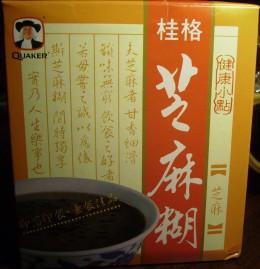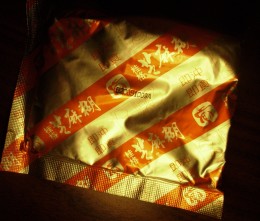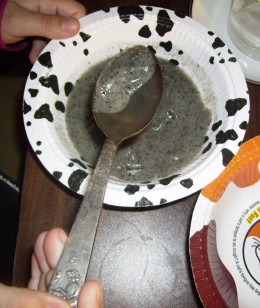Sesame Seeds and Joy
If you saw this box on a grocery shelf, would you know what it was?

If you’ve never experienced functional illiteracy, then this is how it feels. You go into the grocery store, and there are shelves upon shelves of beautifully packaged processed foods, each of them carefully labeled for content. However, you are limited to the pictures on the packages in order to determine what they must contain. My first experience of this was when I moved to Taiwan at the ripe old age of thirty-eight.
I was looking for a breakfast cereal and the Quaker label jumped out at me from a package on the shelf. I didn’t know what it was, but I figured it must be something like oatmeal. Except for the word “Quaker”, everything else on the package was in Chinese. However, there were some pictorial directions on the side. There was a picture of a boiling teapot and water being poured into a bowl that contained something gray. I’m not much of a cook, but this seemed doable. Boil water. Pour into bowl. Definitely something I could do.
So I bought the package and took it home. Inside, there were foil pouches, about the size of an instant oatmeal packet. Only it wasn’t oatmeal! It was a blackish-gray powder that smelled somehow familiar. Not knowing exactly what it was, my senses told me it was an old friend. It was safe. I could try it.


Once I poured the boiling water into the powder and mixed it in, I was already feeling excited. A taste confirmed it. This was good! It was a delicacy. It was not just something I could bear to eat. I would want more and more of it. This made me happy. It was pure joy! It was like going back in time to when I was a little girl. Only, oddly enough, I’d never had this black porridge before. Never! So why was it so familiar? And why was the joy mixed with nostalgia.
After about a week of this, with my enthusiam for the new food growing, I began to get a little concerned. I had started to formulate a hypothesis about what it might consist of. Something I’d had in my childhood. Something I liked that made me very, very happy. Could it be… poppy seeds?
Poppy seeds are everywhere in baked goods in Israel. Poppy seed cake is my favorite. But if these were poppy seeds, and they were ground down, and I was experiencing such euphoria everytime I had breakfast, then could it be there was some opium in there, too?
I began to get worried. Nobody should like a breakfast food this much! What if I was becoming addicted? What if in Taiwan including opium in ordinary foods was perfectly legal. It could contain anything, for all I knew. The ingredients were all carefully listed on the side of the box. Forty something, Four of something else — wait, that’s four pouches, probably, Then 177 big something, like maybe calories — or just the total of the other things listed below? Four of something in public units of measurement. Probably four grams of something. Then five grams of something else. Then 29 grams of another thing. At the bottom, once again, four pouches, (same character for a purse) — one person portion. something, something something 160 — probably grams. Okay, so four times forty would be 160. I could read the numbers, but everything else was conjecture.
I decided I would have to ask somebody at the university. I brought in one of the pouches. “I’ve been eating this for breakfast….”
“You like that? It’s so sweet,” my local colleague replied. “My grandfather likes it. But it’s too sweet for me.”
“Hmm. But what is it?”
“Black sesame seed powder…”
Aha! Not poppy seeds. But a close second. Something else from my childhood.
“So, there’s no opium in it, huh?”
My Taiwanese colleague laughed. “No, just a lot of sugar.”
I am subject to extreme preferences. Most American cereals taste like cardboard sprinkled liberally with sugar. The added sugar in the average cereal doesn’t attract me. But the blackened sesame seed porridge smelled and tasted like home,
It was like the sesame treats of my youth, the halvah and tehina of my Israeli childhood. It confirmed to me that all Asians do share some things in common, and it was my Asiatic upbringing that made Taiwan seem so familiar, even though in most ways it was completely foreign.
Although it is said that sesame seeds were first cultivated in India, the word “sesame”, which is used in most languages for this seed, is in fact of Semitic origin. It comes from Assyrian shaman shammī and means “plant oil”.
Sesame seeds can be light or dark, and they are used in a number of delicacies across Asia, The darker seeds are used further east, while the lighter seeds are prized in the west. Sesame seeds contain important minerals and vitamins, including manganese, copper and calcium, thiamine and Vitamin E. They have antioxidant properties, which can be enjoyed directly from sesame seed oil. These nutrients are easier for us to absorb if the seeds are ground or pulverized.
If you are looking for something different — but good! — you might consider a dish made with sesame seeds. For a person with a high metabolism or one who has trouble putting on weight, halvah or black sesame seed porridge might be a good place to start, as these products offer both carbs and fat. If, however, you have a slow metabolism, are trying to lose weight, or are on a low carb diet, then I highly recommend tehina (also known as tahini) or even just pure sesame seed oil. I’ve used the oil on salads and vegetables, and it has a wonderful flavor all its own.
Make no mistake: the secret of sesame seed goodness is in the oil. Hence the name: shaman shammī.
